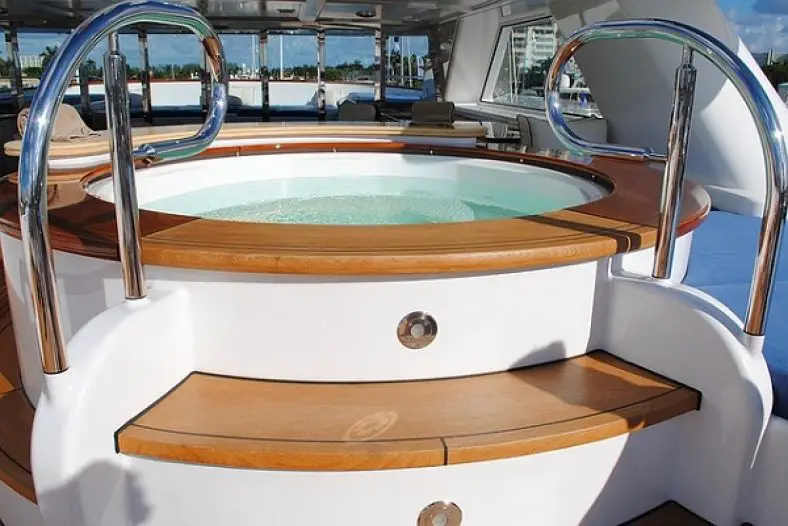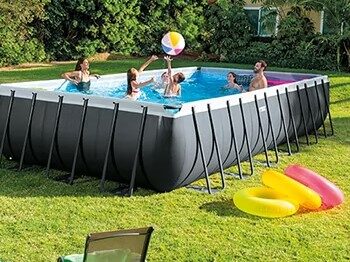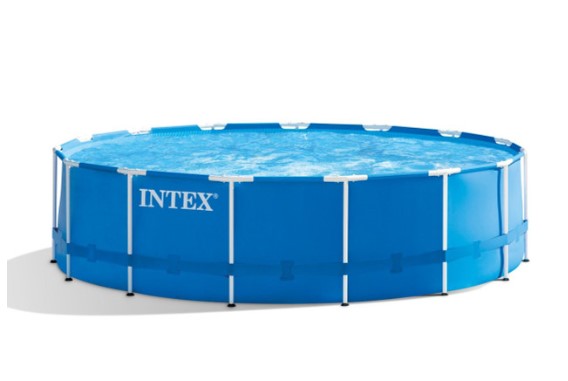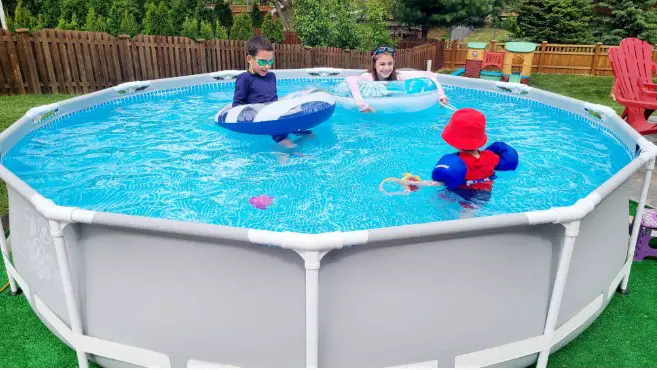Table of Contents
Hot tubs are great for relaxing in.
There’s nothing better than sitting smugly in your hot tub letting the jets massage your back with a nice cool drink in your hand. Bliss!
Unfortunately, bliss comes at a price. In the case of hot tubs, the trade-off is the ridiculous amount of products and effort it takes to keep them sanitary.
When you’re neck-deep in chlorine tablets and bromine, you might be looking for an easier solution and the bottle of bleach in the utility room does seem like a good idea.
But is bleach a good choice? Let’s dive into that.
What You Need To Know
Basic Hot Tub Maintenance
When you have a hot tub that is used regularly you should be testing the water 2-3 times a week.
These tests should tell you the pH balance, the chlorine level, the bromine level, the total alkalinity, and the calcium hardness.
To be safe for use, you should stick to these levels:
- pH: 7.4-7.6
- Chlorine: 1.0-3.0 ppm
- Bromine: 2.0-4.0 ppm
- Total alkalinity: 80-120 ppm
- Calcium hardness: 150-250 ppm
Unfortunately, these levels are all interconnected so an imbalance in one area will affect the imbalance of the whole tub.
Chlorine and bromine are chemicals that kill off bacteria and contaminants.
Bromine is generally more widely used for hot tubs because it is more stable at higher temperatures than chlorine.
Chlorine is generally used once a week to shock clean your tub.
These shock cleanings tend to kill off the things that bromine doesn’t like germs and organic matter that enters the tub with bathers.
The calcium level of your tub will vary depending on how hard your water is. Water hardness is determined by the amount of calcium in it.
The pH is the acidity of the water. 7 is neutral meaning it is neither acidic nor alkaline.
This is the safe range for bathing. If it goes outside of the 7.4-7.6 range it can harm and damage your skin.
The alkalinity of the water is how well the water can resist changes that would make it more acidic. It doesn’t mean that the water itself is alkaline.
Essentially it measures the number of alkaline substances in the water that will neutralize any acids added.
All of these factors link together.
Too much bromine, which is an acidic substance, can alter the pH and reduce the alkalinity of the water.
Too much chlorine will raise the alkalinity levels and alter the pH of the water.
You get the drift…You need to strike that middle ground for.
Using Bleach in a Hot Tub
Ok, now that we understand the basics, let’s look at how bleach would affect these key measurements.
Bleach is a highly alkaline substance. It has a pH of 11 or 12 which makes it more alkaline than ammonia.
Around the house, bleach is great for cleaning floors and surfaces. It kills a lot of bad bacteria and germs that can make us ill.
The issue with using bleach in place of chlorine or bromine is that it is so alkaline it alters the pH and the alkalinity of the tub.
Chlorine has a pH of about 2.9 while bromine has a pH of around 4.
They are on opposite ends of the spectrum and you can’t exchange either for bleach without completely throwing off the balance.
Another problem with bleach is how it kills bacteria.
The hypochlorous acid in bleach breaks down cell proteins. By breaking the bacteria cells, bleach effectively kills them.
Chlorine and bromine, on the other hand, combine with the bacteria to kill it.
When chlorine combines with bacteria most of the chlorine is also burnt off which is why people who use chlorine have to shock treat their hot tubs more frequently.
Bromine combines with bacteria and neutralizes it.
The bromine is reduced but isn’t totally used up.
Bleach doesn’t disappear or reduce when it kills bacteria. It just hangs around which is why it changes the pH.
Bleach Damage to Surfaces
Bleach can damage the interior and exterior surfaces of your hot tub. This is because bleach is highly corrosive.
When we use bleach around the house we tend to dilute it with water before spraying it on our surfaces.
This reduces the amount of bleach that actually comes into contact with the surfaces.
Using bleach to clean a drained hot tub is not the best idea.
Hot tubs are designed to cope with acidic substances like chlorine and bromine.
They are not built to deal with highly alkaline substances like bleach.
If you use bleach in your tub either instead of chlorine and bromine or as a surface cleaner, you will find that the pain and finish of your tub will begin to strip away or bubble.
You are much better off using a dedicated tub cleaner or vinegar if you want to use household products.
When CAN You Use Bleach?
Well, there is one very specific occasion when you can use bleach to clean your hot tub. This is during the shock treatment.
Bleach will definitely shock your tub. You should shock treat your tub once a week if you use it regularly.
If you only use it occasionally, you can take your shock treatments down to a few times a month.
Bleach also removes bromides which are compounds left over from bromine reactions.
Bromides confuse your test strips and show up as bromine but they don’t get rid of bacteria so it’s a good idea to get rid of them.
There are a few things you should consider when using bleach as a shock treatment.
First of all, bleach will significantly alter the pH balance.
You will need to add a different treatment to the water to get it back to normal levels.
Another thing is that bleach will increase the amount of chlorine ppm.
This is because it kills bromides.
When you shock with bleach you will get chlorine readings of about 10 which is between 10 and 3 times the appropriate amount.
Final Thoughts
Bleach might seem like a cheap and easy option, but the reality is that it will do more bad than good.
The only time you can use bleach in your hot tub is for shock treatments. However, using bleach instead of chlorine will ultimately mean that you have to do further treatments to reduce the pH and chlorine levels.
You are far better off using cleaning products designed for hot tubs than improvising with household chemicals.




